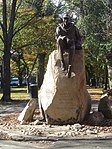Boston & Roxbury Mill Dam
1821 establishments in MassachusettsBuildings and structures in BostonDams completed in 1821Dams in Massachusetts

The Boston & Roxbury Mill Dam was an engineering project in Boston's Back Bay. Commissioned in 1814, the project intended to enclose the Back Bay basin and utilize the flowing tidal waters for industrial production. Constructing the dam would allow water to reliably flow from the Charles River to the basin, creating an ideal environment for the era's industrial mills. The project additionally added a second route to the mainland that redirected traffic away from Boston's choked Orange Street causeway. Between 1818 and 1821, the dam was constructed by extending Beacon Street westward.
Excerpt from the Wikipedia article Boston & Roxbury Mill Dam (License: CC BY-SA 3.0, Authors, Images).Boston & Roxbury Mill Dam
Beacon Street, Boston Back Bay
Geographical coordinates (GPS) Address Nearby Places Show on map
Geographical coordinates (GPS)
| Latitude | Longitude |
|---|---|
| N 42.353663888889 ° | E -71.079063888889 ° |
Address
Beacon Street 234
02116 Boston, Back Bay
Massachusetts, United States
Open on Google Maps








